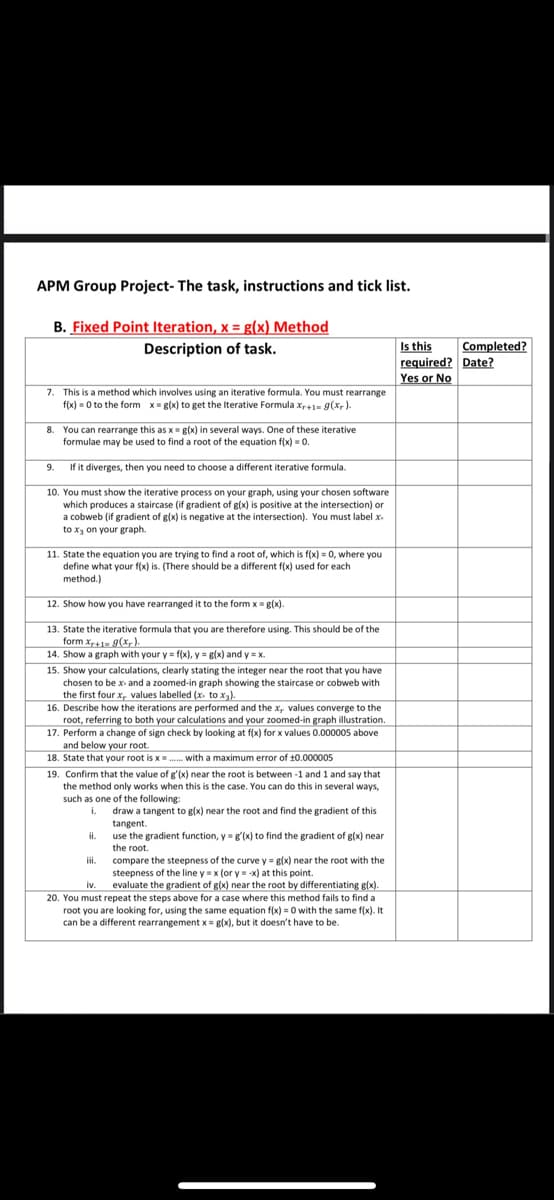Iteration method anx-x-2=0
Algebra & Trigonometry with Analytic Geometry
13th Edition
ISBN:9781133382119
Author:Swokowski
Publisher:Swokowski
Chapter5: Inverse, Exponential, And Logarithmic Functions
Section5.6: Exponential And Logarithmic Equations
Problem 64E
Related questions
Question
Please help ,

Transcribed Image Text:Iteration
method
tan²x-x-2=0,

Transcribed Image Text:APM Group Project- The task, instructions and tick list.
B. Fixed Point Iteration, x = g(x) Method
Description of task.
7. This is a method which involves using an iterative formula. You must rearrange
f(x)=0 to the form x= g(x) to get the Iterative Formula Xr+1= g(xr).
8. You can rearrange this as x = g(x) in several ways. One of these iterative
formulae may be used to find a root of the equation f(x) = 0.
9. If it diverges, then you need to choose a different iterative formula.
10. You must show the iterative process on your graph, using your chosen software
which produces a staircase (if gradient of g(x) is positive at the intersection) or
a cobweb (if gradient of g(x) is negative at the intersection). You must label.x.
to x₂ on your graph.
11. State the equation you are trying to find a root of, which is f(x) = 0, where you
define what your f(x) is. (There should be a different f(x) used for each
method.)
12. Show how you have rearranged it to the form x = g(x).
13. State the iterative formula that you are therefore using. This should be of the
form Xr+1= g(x).
14. Show a graph with your y = f(x), y = g(x) and y=x.
15. Show your calculations, clearly stating the integer near the root that you have
chosen to be x- and a zoomed-in graph showing the staircase or cobweb with
the first four x, values labelled (x. to x₂).
16. Describe how the iterations are performed and the x, values converge to the
root, referring to both your calculations and your zoomed-in graph illustration.
17. Perform a change of sign check by looking at f(x) for x values 0.000005 above
and below your root.
18. State that your root is x...... with a maximum error of ±0.000005
19. Confirm that the value of g'(x) near the root is between -1 and 1 and say that
the method only works when this is the case. You can do this in several ways,
such as one of the following:
i. draw a tangent to g(x) near the root and find the gradient of this
tangent.
ii.
use the gradient function, y = g'(x) to find the gradient of g(x) near
the root.
iii.
compare the steepness of the curve y = g(x) near the root with the
steepness of the line y = x (or y = -x) at this point.
iv. evaluate the gradient of g(x) near the root by differentiating g(x).
20. You must repeat the steps above for a case where this method fails to find a
root you are looking for, using the same equation f(x)=0 with the same f(x). It
can be a different rearrangement x = g(x), but it doesn't have to be.
Is this
required?
Yes or No
Completed?
Date?
Expert Solution
This question has been solved!
Explore an expertly crafted, step-by-step solution for a thorough understanding of key concepts.
Step by step
Solved in 6 steps

Recommended textbooks for you

Algebra & Trigonometry with Analytic Geometry
Algebra
ISBN:
9781133382119
Author:
Swokowski
Publisher:
Cengage


Algebra & Trigonometry with Analytic Geometry
Algebra
ISBN:
9781133382119
Author:
Swokowski
Publisher:
Cengage
